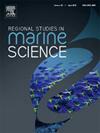Large-scale pattern of metazoan meiofauna as descriptor of environmental gradient along the shelf seas of China
IF 2.1
4区 环境科学与生态学
Q3 ECOLOGY
引用次数: 0
Abstract
Insight into large-scale distribution pattern helps our understanding of the processes in shelf sea ecosystem. Spatial patterns of meiofaunal abundance, biomass, taxon composition and assemblage structure among the five seas (Bohai Sea, northern Yellow Sea, southern Yellow Sea, East China Sea and northern part of South China Sea) along the continental shelf of China were investigated, to examine the latitudinal and depth gradients with the seasonal variation taken into account, and to reveal the environmental factors which may explain the observed pattern. Two-way crossed ANOVA and PERMANOVA tests revealed significant differences in terms of abundance, biomass, number of taxa and assemblage structure at the major taxon level among different seas while seasonal variation was not significant for the assemblage structure and most of numerical characteristics of the fauna. Univariate and multivariate correlation and regression indicated that meiofaunal standing stock and assemblage structure were better explained by the hydrographic features of bottom water, the quantity and quality of food and the sediment granulometry. In general, abundance and biomass of the shelf sea meiofauna showed both latitudinal and depth trends which were negatively correlated with depth and increased with the increasing latitude. Peaks of meiofauna abundance (ind/10cm2) and biomass (μg dwt/10cm2), either of which exceeded 1000, were observed in the Bohai Sea, the northern and southern Yellow Sea, corresponding to the latitudes of the Yellow River Estuary, the Bohai Strait, the frontal system between the Yellow Sea Cold Water Mass and coastal currents, and to the location (27.5–29 °N, 122 °E) in the East China Sea where a nearshore bottom branch of Kuroshio Current was originated and passed by. The large-scale interregional and geographic pattern of meiofauna may act as descriptor for the environmental gradient under the forcing of large river runoff, oceanographic and sedimentary processes along the China shelf sea ecosystems.
求助全文
约1分钟内获得全文
求助全文
来源期刊

Regional Studies in Marine Science
Agricultural and Biological Sciences-Ecology, Evolution, Behavior and Systematics
CiteScore
3.90
自引率
4.80%
发文量
336
审稿时长
69 days
期刊介绍:
REGIONAL STUDIES IN MARINE SCIENCE will publish scientifically sound papers on regional aspects of maritime and marine resources in estuaries, coastal zones, continental shelf, the seas and oceans.
 求助内容:
求助内容: 应助结果提醒方式:
应助结果提醒方式:


